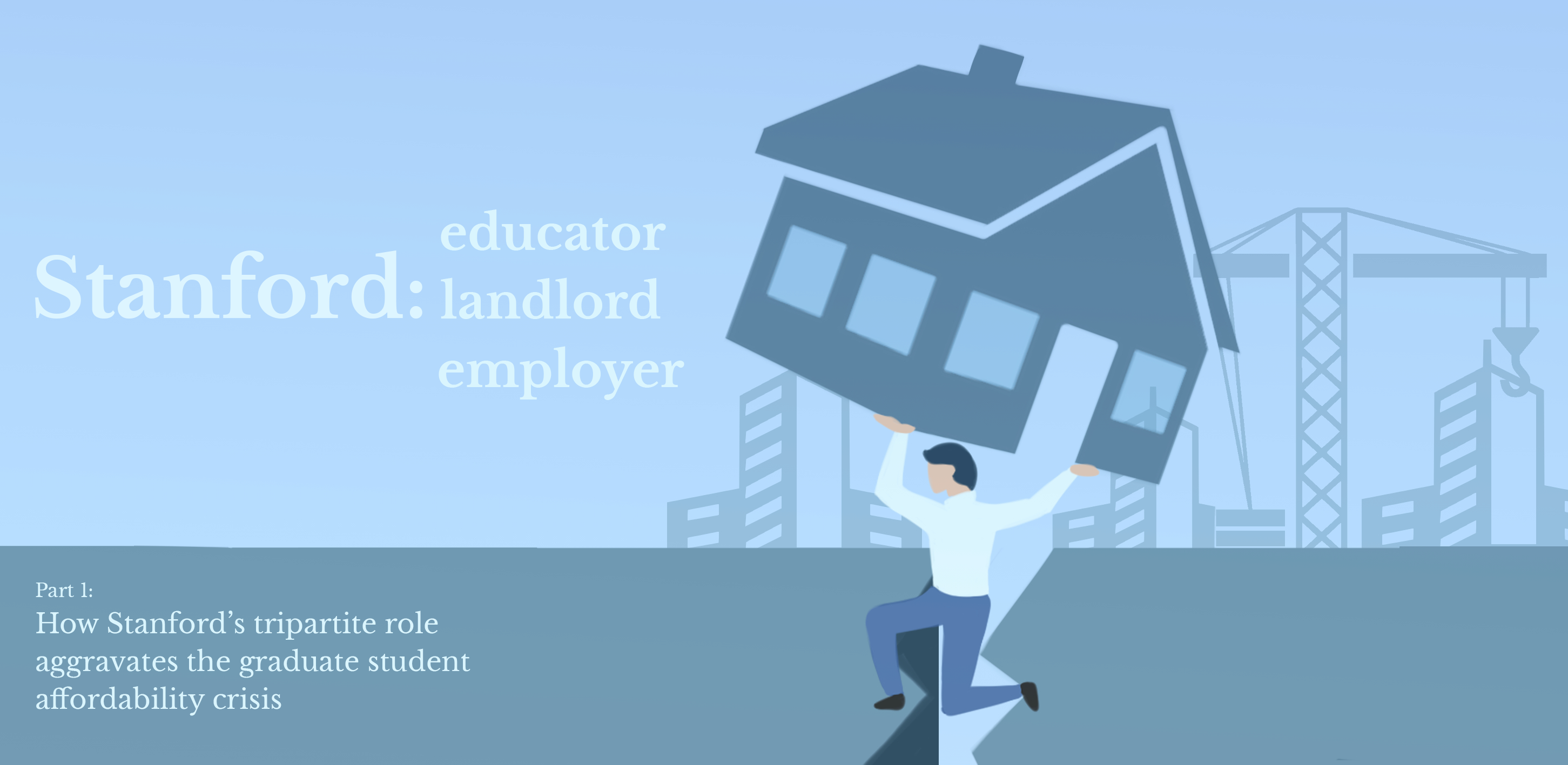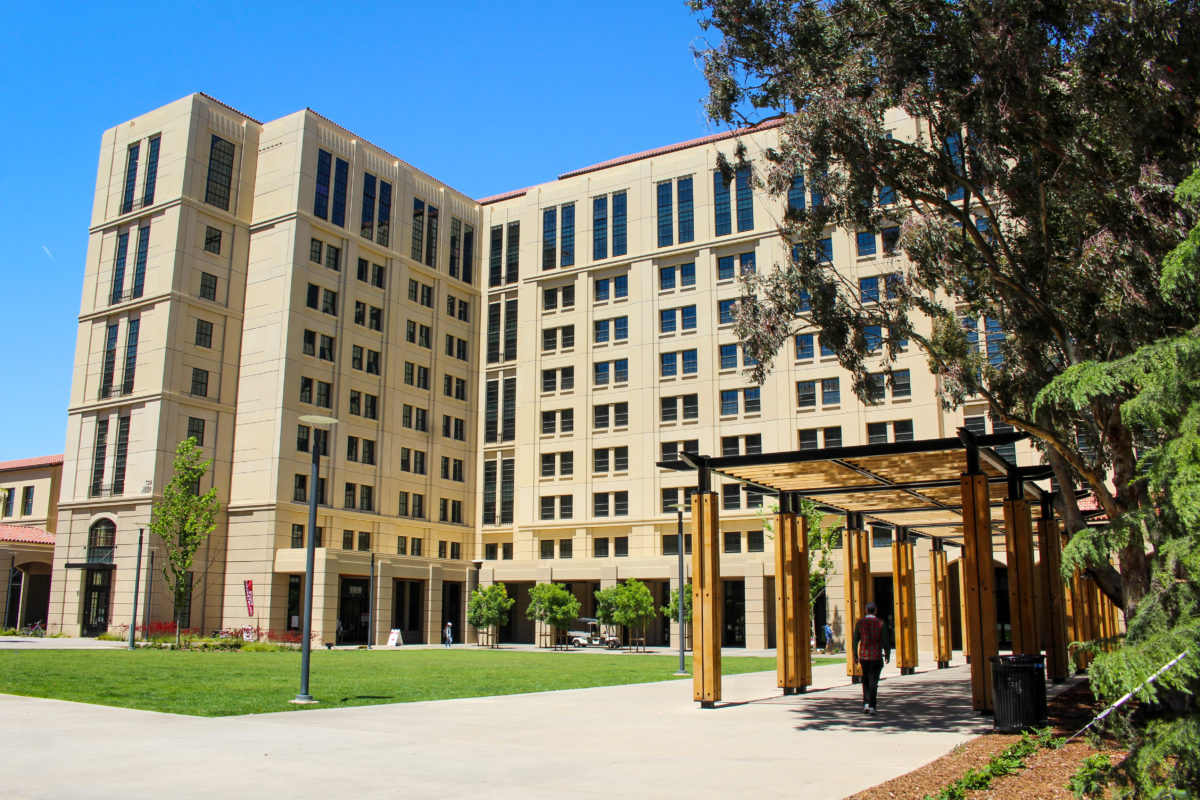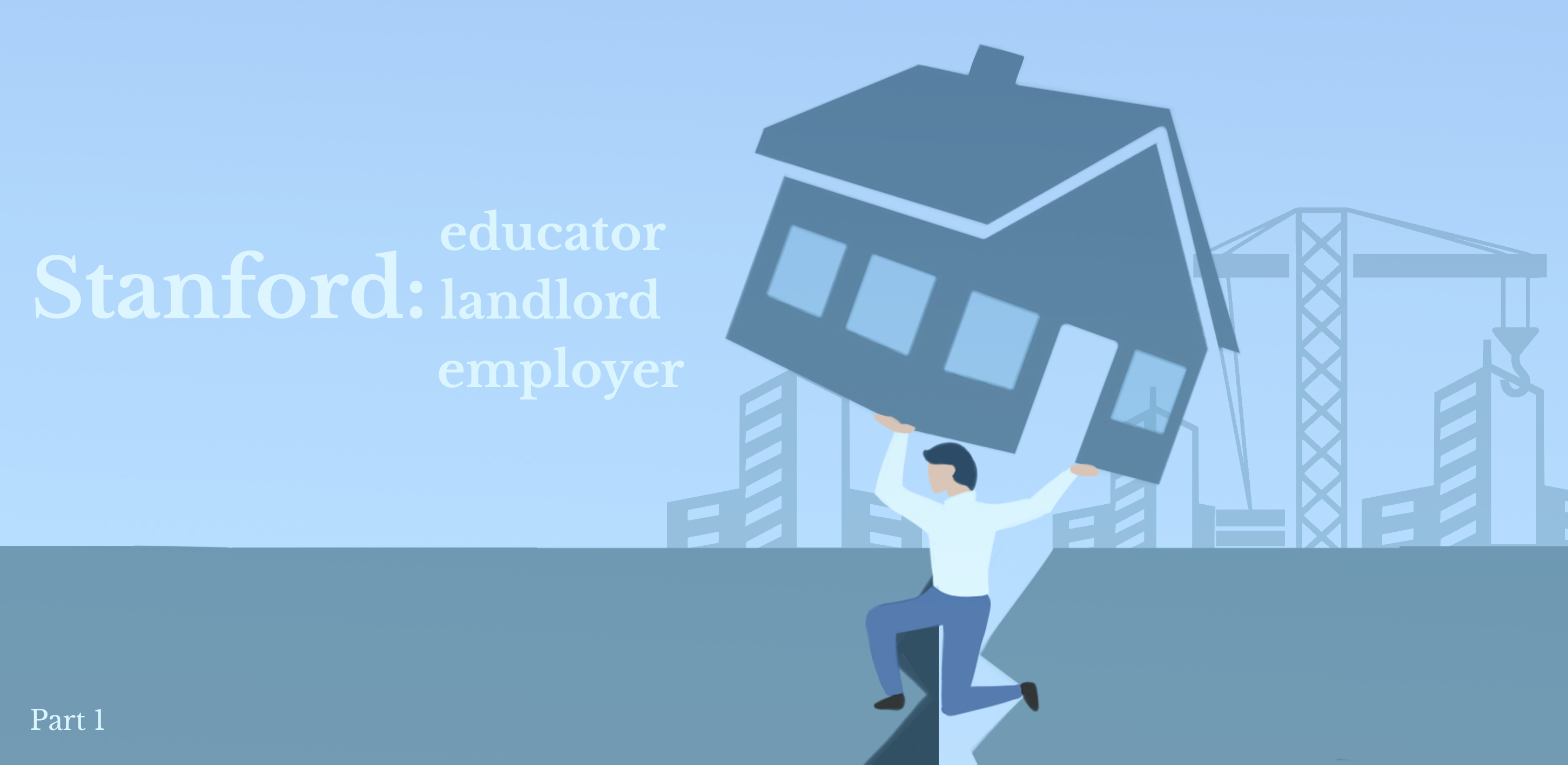
By Tammer Bagdasarian on May 25, 2021
This is the first installment in a series about the challenges of housing insecurity that graduate students face at Stanford. Graphics for the series were created by Hannah Jeoung.
“If Stanford wants to be a city on the hill and make things possible for us … then Stanford cannot also be a predatory landlord,” said fifth-year psychology Ph.D. student Tyler Bonnen. “Stanford is living a double life here. I am living a double life.”
Since he arrived at Stanford less than five years ago, Bonnen has paid nearly $100,000 in rent to the University, approximately half the amount he has earned from Stanford as a graduate student-worker.
“I can’t tell you what that money would mean for my family, what that money would mean for me paying off my student debt, what that money would mean for me as a Black man in academia trying to be upwardly mobile,” Bonnen said.
In the 2020-21 academic year, salaried graduate students working as teaching assistants (TA) or research assistants (RA) shelled out approximately 40% of their salary to Stanford to cover on-campus housing costs each quarter. A tenant is considered rent-burdened if they pay more than 30% of their salary on rent. Around 90% of Stanford graduate student-workers fall into that classification.
University spokesperson Dee Mostofi declined to comment on whether the University considers the rent-burdened status of graduate students when setting rent prices, but she wrote that Stanford created the Affordability Task Force to address regional affordability challenges in 2018 and that “Graduate students remain a top area of focus as Stanford continues to assess how to support the diverse needs of our university populations.”
Mostofi said that the task force has made “consistent progress on these goals,” noting specifically that the University has increased child grants up to $15,000 per year and has provided five-year funding for doctoral students.
When it comes to housing, Mostofi said, Stanford “continues to subsidize the cost of graduate housing at or below the average rate for comparable apartments in the area.” Mostofi added that 88% of single units offered by the University are priced at or below the housing estimate in the Cost of Attendance provided by the Financial Aid Office.
But as rent prices in the Bay Area plummeted during the COVID-19 pandemic, Stanford has held fast to its practice of raising rent year after year. In 2020, rent for single student housing on campus increased by 4.5% and is slated to increase by approximately 3.5% this year, according to representatives from Stanford Residential and Dining Enterprises (R&DE).
Stanford’s graduate student population is diverse — some students are fresh out of college, whereas others came to campus in their 40s. Individual situations vary, with many relying on their salaries to support their families on campus or loved ones across the world.
In a year that has put immense strain on the University community, the dependability of a stable salary and housing has been crucial for many. At the same time, it has put many graduate students living and working at Stanford at the mercy of the University. For graduate students, many of whom are required to work for Stanford and no other entity, the University is not just an academic institution: It is their landlord and their sole source of income.
The vast scope of Stanford’s influence over graduate student lives has left some feeling trapped and acutely powerless during the pandemic, multiple students said. The University expanded Emergency Grant in Aid funds to cover unexpected health or travel expenses related to COVID-19 for the duration of the pandemic. But, moving home or to a cheaper location was no longer a viable option for those who feared catching the virus or spreading it to family members, and graduate student workers reported having no choice but to accede to University rent practices.
For Bonnen, who comes from a low-income background, the feeling of powerlessness in the face of University decisions rang especially true this academic year: “When the pandemic began, everyone in my family lost their job,” Bonnen said.
“I started supporting my family financially so that they could pay their rent, so they could eat. It’s important to remember that Stanford’s actions don’t just affect each of us as individuals. Stanford’s actions reverberate throughout our families, throughout our communities.”
Stanford the employer
The University’s unique positioning as both a landlord and an employer can put graduate student-workers in a tight financial spot. Ph.D. students at Stanford are required to obtain funding for their research, primarily by working as a TA or RA for the University. While these students earn a quarterly salary from the University, that is often the extent to which they can support themselves financially while at Stanford — many graduate student-workers’ contracts prohibit them from working for a non-Stanford employer during the academic year, according to Bonnen.
For international students, the restrictions are even more stringent: Federal policy prohibits student visa holders from working more than 20 hours per week while school is in session.
While the amount a graduate student can earn is essentially capped, there is no limit on the proportion of salary that rent can comprise, according to Graduate Student Council (GSC) co-chair KC Shah J.D. ’22.
Still, the University has repeatedly justified rent increases by citing annual salary increases for graduate student-workers in public and private meetings. During the 2020-21 academic year, the average salary for a TA or RA rose by 4.5%, and is set to rise by 3.2% this year.
While the raises help graduate students pay off their increasing expenses, using salary increases as justification for rent hikes represents a pitfall of having one institution as an employer and a landlord, according to Jamie Fine, a fourth-year modern thought and literature Ph.D. student, co-chair of the graduate student advisory committee and current GSC councilor.
“I was told point blank that we see stipend increases and these increases are directly tied to increased housing costs,” Fine said. “I’m not sure if one is the result of the other or which direction it goes in, but this is an incredibly flawed notion.”
Graduate student-workers often have financial responsibilities beyond basic living expenses, but when rent takes up such a large portion of student-worker salaries, some students are forced to resort to other means of gaining income.
“The stipend that I make is not enough for me to pay my rent, to pay my student loan bills, to pay for my food and to pay for my transportation costs,” Fine said, adding that she normally expects to work throughout the summer as a TA or RA, or to help with summer programming to cover her expenses. “COVID cut that off. So last summer, it was a dead time. This summer, it’s looking again like a dead time.”
Avenues of advocacy are limited. Multiple graduate student-workers interviewed by The Daily said that they feel they have to hold back from complaining about rising rents for fear that something they say could get back to their department and threaten their academic status.
When it comes to protesting rising rent prices, strength can come in numbers. In 2020, students at 45 universities in the United Kingdom participated in rent strikes, and in April, graduate students at the University of California, San Diego went on strike to protest a one-time hike in rent prices.
“I think if we began to, for just a moment, realize that we are working 90 hour weeks for subsistence pay, and most of that is going back to our employer,” Bonnen said, “I don’t think that the situation would hold for very long.”
Paying for a billion-dollar complex

In 2017, Stanford embarked on a project to expand housing options by building the Escondido Village Graduate Residences (EVGR) with plans to house 7,000 graduate students. The cost of the project topped $1 billion, but the buildings still haven’t served their original purpose: The complex was temporarily converted to all-purpose housing during the COVID-19 pandemic.
The costs will be shouldered in large part by students. At an average of approximately $1,766 per occupant in the 2020-21 academic year, EVGR was the second-most expensive housing option for graduate students on campus after Munger, which costs occupants approximately $1,981 on average. Prior to the pandemic, the addition of EVGR — where rent prices are significantly higher than in other buildings — was expected to be responsible for a 16% spike in average rent costs across all graduate residences from the previous academic year, even though individual single-student housing rates increased only 4.5%.
Still, the University continues to refer to EVGR as subsidized housing, helping satisfy Santa Clara County below-market-rate housing requirements.
But for students living on a graduate student salary, EVGR is hardly affordable.
“Here, subsidized housing is an actual joke, it’s a euphemism for anything under $3,000 or $4,000,” said Chiara Giovanni, a fourth-year comparative literature Ph.D. candidate. “This has never been about protecting us.”
The percentage of affordable housing — defined as costing a maximum of 30% of income — offered by the University decreased from 18% to 10% year over year, according to a fact sheet by the Stanford Solidarity Network.
“When asked repeatedly point blank, housing has told us they will not be decreasing the cost of rent in light of the fact that there’s a new building,” Fine said. “I don’t think it’s our responsibility to be the people who are offsetting the costs of a juggernaut of a building.”
In meetings between Residential & Dining Enterprises (R&DE) and the GSC, R&DE representatives have contended that they cannot lower EVGR rent because R&DE relies on that money to fund debt-servicing for the buildings and pay for on-campus labor.
According to GSC co-chair and fourth-year communication Ph.D. student Sanna Ali, who lives in EVGR, the University’s logic can be broken down into a simple equation: “They spent way too much money on this building, and now they’re charging really high rent to be able to break even.”
According to Ali, the gap in the logic lies in the disconnect between the University and graduate students’ priorities.
“I don’t care if I live in a billion-dollar building,” Ali said. “But in some of these older buildings there is dust that seeps through the doors, there are pests everywhere and they are still charging the same rates as before. I guess the prioritization was ‘let’s just make this giant high rise,’ instead of ‘let’s make housing more livable and more affordable.’”
While R&DE executes Stanford’s housing policies, some of the issues that students cite can be attributed to the University’s decentralized organizational structure. Stanford classifies R&DE as a “major auxiliary unit,” or a self-supporting entity intended to furnish goods and services to the community. That expectation that R&DE brings in enough money to sustain itself provides the entity with limited leeway to lower rent to more affordable rates.
The structure can also put graduate student advocates in a maze as they try to understand where to best direct their efforts, according to Shah.
“Advocates get the typical run around when talking to R&DE about the rising cost of rent, even in lieu of falling rental costs in the area,” Shah said, explaining that R&DE and the Board of Trustees often direct advocates to the other entity. “So then where do you go next?”
Students with special circumstances
International graduate students are situated at the nexus of many of the issues graduate-student workers face at Stanford. For Giovanni, a first-generation, low income student from the United Kingdom, Stanford’s housing policies are not just inconveniences. Rather, they are non-negotiable requirements that she must follow, no matter the emotional and financial toll they may take.
“My Ph.D. fellowship is truly the only money that I have,” Giovanni said. “Many of my friends at least have some sort of safety net. I don’t, and a lot of us here don’t.”
As an international student unable to return home during the pandemic, Giovanni said she feels the University has added leverage over her housing and work situations.
“When the University makes these policies, it definitely comes from a place of really not thinking of us as real people with hopes and dreams and fears and plans,” she said. “We’re not disposable.”
While monthly rates for comparable single-bedroom apartments in other parts of the Bay Area can be lower than Stanford housing, renting off campus often requires frontloaded deposits, an unrealistic option for those relying on a graduate student salary to survive. This leaves many with only one choice — stick it out and hope that things will change.
“When we asked explicitly about rent freezes or rent reductions during the pandemic, the answer was always kind of like, if you’re not happy, you can move out,” said Florian Tramer, a fifth-year computer science Ph.D. student from Switzerland. “Well, it’s not that simple for a lot of us.”
Without a family nearby or external funds to fall back on, a graduate student salary is an insufficient safety net, Ali added. While Stanford graduate students are highly sought after for well-paying jobs outside of Stanford, students on F-1 visas are legally prohibited from working for any outside entity.
“We’re prevented from gaining other sources of income, so we are completely beholden to the institution,” Giovanni said.
The situation can grow even more complex for international students with partners. Tramer, who lives with his wife in McFarland, a mid-rise in EVGR, said he and his wife are required to pay more than twice the sum that individual residents pay for nearly identical housing in the same building.
Couples rent in McFarland totals $2,250 per month, whereas two individuals living together would pay only $1,000 each. Federal visa law requires married international graduate students to show that they will be able to earn enough money to support themselves and their potentially unemployed spouses, according to Tramer.
“When I get the deductions of my Ph.D. salary, and pay Stanford for healthcare and housing, I’m left with $200 or $300 per month to live on,” Tramer said.
In Tramer’s case, his wife, who works outside of Stanford, is able to help support the two of them. But paying an additional $250 per month on housing still totals thousands of dollars of additional spending during the normal length of a Ph.D. program, a sum that can make a tangible difference for many students relying on a graduate student salary.
Tramer said that when he asked why he and his wife were being charged more than twice what a single student would pay, the University responded that the price takes into account the different lifestyle of partners compared to single roommates.
“It is kind of strange, because from Stanford’s perspective, the costs are the same,” Tramer said. “I even have some friends who live in couples housing and are both Stanford students, so you’re telling me that if they were just considered not a couple, they could be paying less rent?”
In the face of such widespread disconnects between the interests of graduate students and the actions of administrators, both parties face the dilemma of how to narrow the rift. To Bonnen, change will come only if Stanford and graduate students are able to take an honest inventory of the outsized role the University plays in so many different facets of graduate student lives.
“We as graduate students are so enamored with Stanford the educator that we are willing to endure so many other things on behalf of Stanford the employer or Stanford the landlord,” Bonnen said. “I think Stanford is quite aware of that.”
